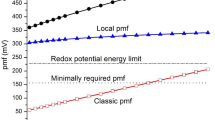Summary
Measurements of interfacial electron flow indicate that membrane fragments rich in Na+−K+-ATPase are capable of absorbing and releasing electrons in the form of random currents at an electrode surface. The electron transporting system, which functions in the presence or absence of substrate and activating ions, may be part of or in contact with the enzyme system, but it is not related to the ATPase activity. The observed electron transport at an electrode surface resembles physiological electron transport processes in being reversible, in extending over the same range of potential, and in being affected by some of the chemicals that interfere with electron transport and oxidative phosphorylation in mitochondria. Our experiments do not provide sufficient evidence to identify the substances that are responsible for the random currents, but the results suggest that the electro-active substances are similar to those which are involved in the reactions at the second phosphorylation site in mitochondria. Experiments with this technique provide a new approach to the study of the mechanism of biological electron transport processes and their possible relation to ATP synthesis and hydrolysis.
Similar content being viewed by others
References
Blank, M., Miller, I. R. 1968. Transport of ions across lipid monolayers. I. The structure of decylammonium monolayers at the polarized mercury-water interface.J. Colloid Interface Sci. 26:26.
Britten, J. S., Blank, M. 1968. Thallium activation of the (Na+−K+)-activated ATPase of rabbit kidney.Biochim. Biophys. Acta 159:160.
Garahan, P. J., Glynn, I. M. 1966. Driving the sodium pump backwards to form adenosine triphosphate.Nature 211:1414.
Glynn, I. M. 1963. Transport adenosinetriphosphatase in electric organ. The relation between ion transport and oxidative phosphorylation.J. Physiol. 169:452.
Klingenberg, M. 1968. The respiratory chain.In: Biological Oxidations. T. P. Singer, editor. p. 3. Interscience Public., New York.
Mahler, H. R., Cordes, E. H. 1966. Biological, Chemistry. Chapter 14. Harper & Row Publ., Inc., New York.
Miller, I. R., Bach, D. 1969. Structure and membrane properties of lecithin monolayers at the polarized mercury/water interface.J. Colloid Interface Sci. 29:250.
—, Blank, M. 1968. Transport of ions across lipid monolayers. II. Reduction of polarographic currents of Cu(II) by decylammonium monolayers.J. Colloid Interface Sci. 29:34.
Racker, E. 1965. Mechanisms in Bioenergetics. p. 108. Academic Press, New York.
Robertson, R. N. 1968. Protons, Electrons, Phosphorylation and Active Transport. Cambridge Univ. Press, Cambridge.
Skou, J. C. 1965. Enzymatic basis for active transport of Na+ and K+ across cell membrane.Physiol. Rev. 45:596.
Author information
Authors and Affiliations
Additional information
Supported by U.S. Public Health Service Research Career Development Award K3-GM-8158.
Rights and permissions
About this article
Cite this article
Blank, M., Britten, J.S. Electron flow at the polarized mercury-water interface in the presence of membrane fragments rich in Na+−K+-Activated ATPase. J. Membrain Biol. 2, 1–16 (1970). https://doi.org/10.1007/BF01869846
Received:
Issue Date:
DOI: https://doi.org/10.1007/BF01869846




